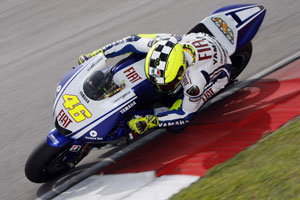Riding smooth not only helps you ride faster, it keeps you consistent and is less fatiguing, too.

PUSHING THE LIMITS
While it’s important to keep your riding smooth, be sure to continue evolving your style and continue moving the goal posts. What seems smooth today will probably feel slow in a year’s time, so always focus on moving forward and improving.
Plenty of seat time will ensure you improve in a sensible manner, allowing you to take the necessary steps to improve over time with added experience. No matter how talented you may be, everything takes time — especially riding fast at a comfortable pace.
And what is fast exactly?
Going fast on the road is being able to feel comfortable at the indicated speed limit, which is tricky sometimes in the open areas. Being a fast rider on the road is essentially the guy who seems the breeze through each section of road smoothly.
As for the track, there are many levels of being fast on the track. Whether you’re a club champion or world beater it’s all relative to what your goals are.
Smooth is fast, so work on that first and foremost and then the speed will come naturally.
Smoothness is the key to a good time and great results when riding a motorcycle — no matter what your goals may be.
Even while pushing the absolute limits of man and machine in MotoGP, Valentino Rossi keeps it almost as smooth as silk lap after lap on his Yamaha YZR-M1.
Being smooth not only helps us go that bit quicker if that’s your aim, it also helps to minimise the risk of a vital mistake or an accident. Riding smoother gives more control and being in control is one of the most important aspects of riding.
Riding out of your comfort zone and beginning to take risks is when accidents happen as mistakes are made. Getting out of your comfort zone also usually means slower riding, too.
We are all guilty of riding above our potential at times, usually ending in a slide down the road, but consistency is often the first step to being able to ride faster on the track or in the real world.
Whenever you do go for a ride, always ensure that you ease into the ride and get a feel for things before you begin to push too hard, too soon.
At the track it’s especially common to see guys turn up late, rush to sign in and get set up, before eventually getting on track and trying to go as fast as possible straight away.
This usually leads to erratic riding after not having correct preparation, putting the entire day out of sync.
Likewise on the road, when you’re running a touch late to meet your group at a petrol station or pub, it’s common to rush and throw on your gear, racing out of the garage and blasting off down the street.
Those are both good examples of a bad start to the day and are good ways to throw smooth riding straight out the window.
Always ease into the ride and use the first 20 minutes (or opening session at a track day) to warm up, allowing you to focus your mind on the job at hand and also allowing your body to adjust to another day of riding.
If you do go too hard too soon it can upset your rhythm and potentially ruin your day.
Usually, if you begin slower and warm up properly, getting a feel for everything on that particular day, you will end up being faster in the end. Jumping on and going hell for leather from the start usually leads to reaching a limit quickly, which is hard to advance past if you rushed into the day and have been riding on edge from the beginning.
Once you are warmed up and feeling comfortable and confident on the bike, continue to practice smooth riding, gradually increasing your speed in a more controlled manner, which really helps you progress in the end.
For the racers it’s important to push relatively hard during the first session, but at most professional levels you will see that the second practice times are much faster than the first at almost every event.
The question is, what are the most important factors you want to practice when working on smooth riding?
- Body transition: Transitioning your body from a tuck position to a cornering position (and back again) sees many do it in stages, rather than in one smooth motion. Always try to manoeuvre around the bike precisely in order to help keep the balance settled.
- Throttle control: Everybody knows that throttle control is vital, but many are still not smooth enough with it. Next time you ride, consciously analyse if you snap it on and aren’t smooth enough. Not only focus on this when applying throttle, concentrate on deceleration, too.
- Braking: Applying the brakes in one smooth motion is another important piece of the puzzle. Choose your braking point and apply them in one constant squeeze. Constantly applying them until you’re slowed down enough for the turn is much better than having a few hard stabs at the brake lever.
- Line selection: Commit to your turn-in point and steer the bike in one smooth motion around the corner. Once you get really consistent at selecting turn points, you will flow from turn to turn much better than re-adjusting three times in each corner.
- Gear shifting: Smooth shifting will help keep the whole package together, eliminating chatter when shifting down too quickly under brakes and allowing you to flow. Change down one gear at a time, without rushing and slamming down through the ’box.
Keeping those five factors in mind when riding will allow you to piece the whole package together, because it’s often important to consciously focus on these things in order to stay smooth.
Once again, smooth riding equals consistent riding, and after your game is consistent, that’s when you can really begin to improve your performance on the bike.






